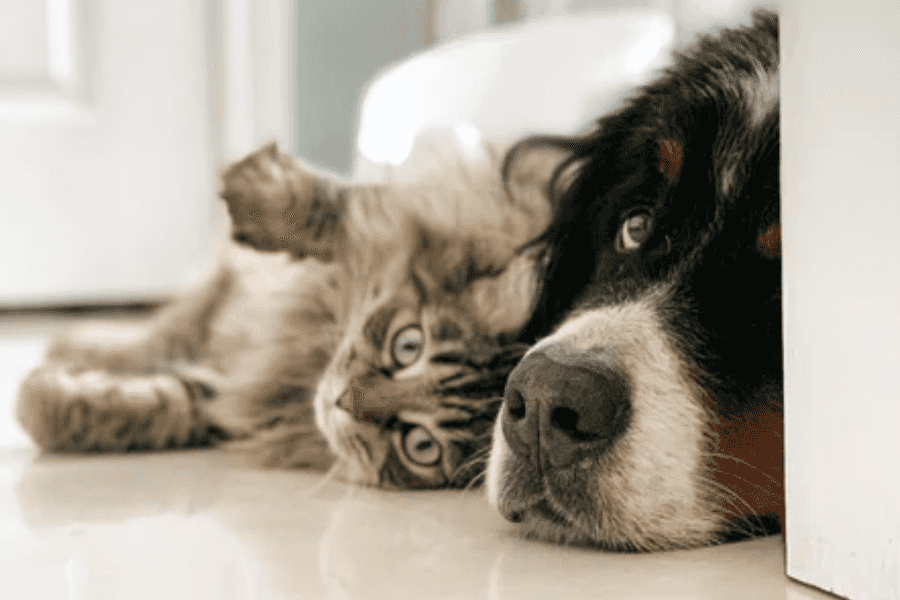What Are The Differences Between Cat And Dog Food?

If you have both cats and dogs living under your roof, you’ve probably wondered whether your pets can eat each other’s food. After all, it would be much easier to buy just one type of pet food, right? ![]()
While it may be tempting to feed both species the same food, there are good reasons why cat food and dog food are formulated differently.
Cats and dogs have very different nutritional requirements. Feeding the wrong diet can lead to nutrient deficiencies and health problems over time.
In this post, we’ll explore the key differences between cat and dog food and why it’s important to feed each pet the diet specifically designed for their species.
Cats Are Obligate Carnivores, While Dogs Are Omnivores

The most significant nutritional difference between cats and dogs relates to their evolutionary adapted diets.
Cats are obligate carnivores, meaning they must eat meat to survive. Animal-based proteins and fats provide the essential amino acids, vitamins, and fatty acids cats need.
Dogs, on the other hand, are omnivores. They can thrive on a varied diet including meat, grains, fruits, and vegetables.
Let’s look closer at how these different dietary adaptations impact your pets’ nutritional requirements.
Cats Need More Protein from Animal Sources
Since cats evolved as meat eaters, they require a high-protein diet, with a minimum of 26% protein on a dry matter basis.
Not only do cats need a lot of protein, but it must come from animal sources. Plant proteins like soy or corn don’t provide the essential amino acids cats require.
Taurine is one example. This amino acid is critical for eye and heart health in cats, yet their bodies cannot synthesize it. Taurine must be obtained from animal tissues like poultry, fish, and meat.
Dog food contains lower and more varied protein sources than cat food. While not inherently dangerous, it doesn’t align with the feline body’s high protein requirements.
Dogs Can Thrive on More Plant-Based Proteins
As omnivores, dogs can utilize plant and animal protein equally well. The minimum dietary protein requirement for dogs is only 18% on a dry matter basis.
Dog food contains protein from both animals (chicken, lamb, fish) and plants (soy, corn, wheat). This mix provides balanced essential amino acids.
Not only is dog food lower in protein than cat food, but a good portion comes from plant ingredients. Since cats require protein from animal tissues, dog food is deficient in the meat-based protein sources they need.
Cats Require Specific Amino Acids Dog Food Lacks

Beyond overall protein content, cats also need higher levels of certain amino acids not found in sufficient amounts in dog food.
Let’s look at some of the key amino acids cats require:
Taurine
Taurine is only found naturally in animal proteins. It supports eye health, heart function, and reproduction in cats.
Unlike cats, dogs can synthesize their own taurine as long as the diet provides sufficient sulfur amino acids like methionine and cysteine.
Since dog food contains more plant proteins lacking taurine, it cannot meet the higher requirement of cats. Feeding cats dog food long-term leads to taurine deficiency, causing vision and heart problems.
Arginine
Arginine is another amino acid essential for cats but not dogs. It helps cats efficiently process and excrete ammonia.
Insufficient arginine causes toxic ammonia build-up, leading to symptoms like drooling, stumbling, and head shaking. Dog food won’t provide the higher arginine content cats need.
Methionine
Methionine is required by both cats and dogs, but cats have a higher minimum requirement. This amino acid supports urinary tract health in cats.
Dog food can still be deficient in methionine because plant proteins like soy contain less of this amino acid than meat.
Cats Need Specific Fatty Acids Found in Meat

Certain fatty acids are also essential for cats but either unnecessary or synthesized by dogs. Since these come from animal fat and tissues, dog food is a poor source.
Arachidonic Acid
Arachidonic acid supports skin health, gastrointestinal function, and platelet aggregation in cats.
Dogs and humans can synthesize arachidonic acid from other fats. Since cat food contains ingredients rich in this fatty acid like poultry fat, eggs, and fish, dog food is deficient.
Omega-3 Fatty Acids
Omega-3s like EPA and DHA support skin and coat health in cats. They are found abundantly in fatty fish like salmon and sardines.
While omega-3s are beneficial to dogs as well, their requirements are lower than cats. Dog foods providing only plant-based ALA omega-3s may be insufficient for cats.
Dog Food Doesn’t Provide Enough Vitamins for Cats

Cats also need higher levels of certain vitamins compared to dogs - amounts dog food won’t supply sufficiently.
Vitamin A
Cats have a higher requirement for vitamin A than dogs. It supports their vision, immune function, growth, and reproduction.
Since ingredients rich in vitamin A like liver are used more abundantly in cat food, dog food is often marginal in this vitamin for cats.
Niacin
Niacin helps cats effectively utilize energy from fat and protein digestion. It also supports skin and coat health.
Dog food provides lower amounts of niacin that may be insufficient for cats long-term. Signs of deficiency include inflamed gums, dermatitis, and diarrhea.
Riboflavin
Riboflavin supports vision, muscle development, and digestion in cats. Dog food likely provides enough for basic canine needs but not the higher feline requirements.
Dog Food Contains Additives Harmful to Cats

Some additional ingredients commonly added to dog food can actually be dangerous to cats:
Propylene Glycol
Propylene glycol is added to some dog foods and treats to retain moisture. It’s safe at low doses but toxic to cats in larger amounts.
Since cat food avoids propylene glycol, even small amounts ingested from dog food can potentially cause Heinz body anemia in cats when consumed long-term.
High Vitamin D Content
Too much vitamin D causes calcium to deposit in soft tissues, leading to kidney failure in cats.
Some dog foods may provide excessively high vitamin D well beyond the safe upper limit for cats. This can occur if vitamin mixes intended for dogs are used.
Onion and Garlic Powders
Trace amounts of onion or garlic powders added for palatability in dog food can be toxic to cats over time.
Due to cats’ increased sensitivity, both ingredients are avoided in cat food. Small amounts from dog food can potentiate anemia in cats when fed continuously.
Cat Food is Richer and May Cause Obesity in Dogs

Finally, since cat food is more calorically dense and fatty than dog food, it can easily cause obesity if fed long-term to dogs.
Here’s a comparison of an average dry cat and dog food:
| Nutrient | Cat Food | Dog Food |
|---|---|---|
| Protein | 42% | 25% |
| Fat | 20% | 15% |
| Carbs | 29% | 50% |
| Calories | 4,000 kcal/kg | 3,500 kcal/kg |
The higher fat and protein content make cat food around 14% more calorically dense per cup than dog food.
These higher calories served in smaller meal sizes to match a cat’s appetite can quickly lead to weight gain in dogs.
Obesity stresses all of the body’s organs, especially the heart and joints of larger dog breeds prone to these issues.
Signs Your Pet May Be Eating the Wrong Food
While the occasional piece of contraband probably won’t harm your pet, you should watch for these signs of dietary mismatch if your pet access the other species’ food regularly:
In cats:
- Weight loss from insufficient calories/protein
- Poor coat, skin, or vision issues
- Heart disease
- Loss of muscle mass
- Increased vomiting or diarrhea
- Lethargy
In dogs:
- Weight gain or obesity
- Flatulence or diarrhea
- Pancreatitis
- Increased liver enzymes
- Skin irritation or inflammation
- Food allergies
If you spot any of these symptoms, take your pet to the veterinarian for an exam. Bring a sample of all foods they are eating to help identify the problem.
Tips to Transition Your Pet to New Food

If your veterinarian recommends switching your cat or dog to a more appropriate diet, follow these tips for a smooth transition:
Gradually transition over 5-7 days, starting with 25% new food mixed with 75% previous food and slowly increasing the new while decreasing the old.
Ensure your pet eats all food served during the transition to prevent nutritional gaps.
If your pet has difficulty adjusting to the new texture or taste, consider adding warm water, low-sodium broth, or a pet-safe food topper to enhance palatability.
Monitor your pet during the transition and notify your vet if they experience diarrhea, vomiting, or loss of appetite lasting more than 24 hours.
Once transitioned, watch your pet closely for health improvements like increased energy, better skin and coat, regular digestion etc. Notify your vet if these don’t start to resolve within 3-4 weeks on the new diet.
The Takeaway: Feed Cat Food to Cats and Dog Food to Dogs
Cats and dogs evolved eating very different diets, so their nutritional requirements vary more than you might expect.
Here are some key points to remember:
Cats are carnivores requiring high animal protein and fat, while dogs are omnivores needing more balanced protein and carbs.
Cat food is formulated with more meat-based protein and vitamins cats require but dogs can synthesize.
Dog food contains plant protein and additives that may be harmful to cats long-term.
Though occasional shares are unlikely to hurt, exclusive long-term feeding of the wrong food can lead to nutritional disease.
Watch for signs of dietary mismatch like digestive upset, skin issues, lethargy or obesity and consult your vet.
Feeding species-appropriate diets formulated just for cats and just for dogs is the healthiest approach. Your pets will feel their best eating foods tailored just for them!
Check out our articles on how often you should brush your cat’s teeth and why cats can’t drink milk to learn more about caring for your feline friends. Dog owners may be interested in our tips on how to stop your dog from shedding.
Tags
Share
Table Of Contents
Related Posts
Quick Links

